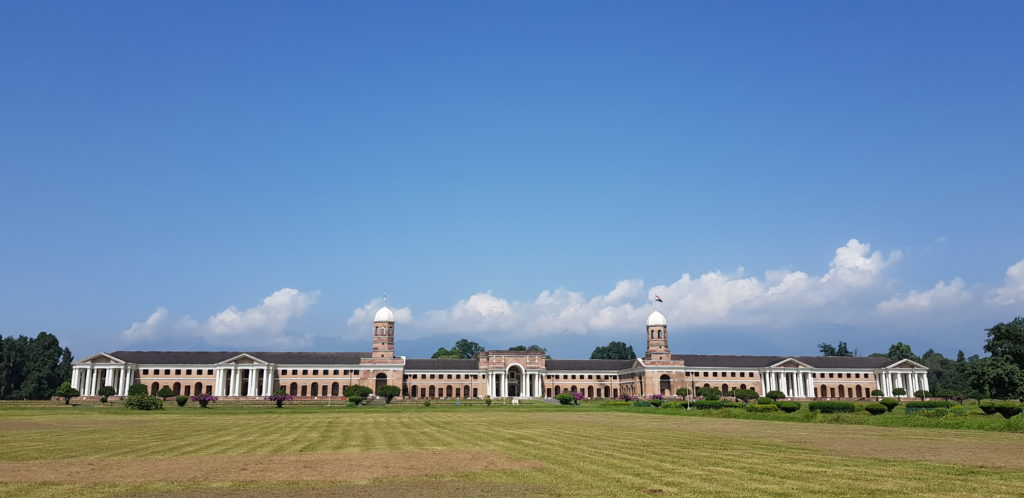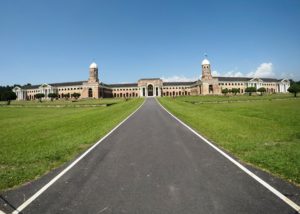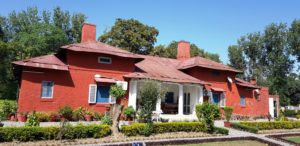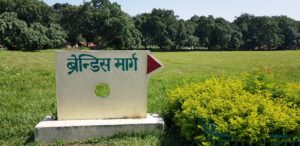It’s like John Wick – unless you know the history, you are just looking at a brooding, pretty façade. But under the sempiternal glow of the autumn sun falling unfiltered through a cloudless sky, even the air beholds the sprawling regalia with a breathless stillness. In the boughs and boles, even those afar, one detects a hushed awe. With name and genus tags though they all look very business-like, they have wilfully succumbed to the glory in their midst. Look at the branches of the Weeping Fig for example – these arching ones resemble the pious limbs of a devout supplicant. Basking in the attention, flaunting a demeanour of unrivalled concrete gentry, a head full of conviction of its own priceless heritage, sits the Forest Research Institute of Dehradun.
Part abbey and part Acropolis, the FRI in its current construct and location was opened on November 7, 1929. It was built along Greco-Roman lines by CG Blomfield who is known as ‘the last architect of the Raj.’ Blomfield arrived in India in 1913 when construction of Delhi was about to commence. As an assistant engineer with the Delhi PWD, he built many of the bungalows in what later came to be clubbed under ‘Lutyens’ Delhi’ named after his more famous peer Edwin Lutyens. One can well imagine the industry and passion which charged Blomfield when the opportunity came his way – it was not just a hallowed premise of higher learning but also a chance to emerge from the shadows of the chief architect of the national capital. Even probably reclaim some of the unfairly appropriated name. The appreciation that followed the FRI might have even been an impetus for him to stay on in India till his retirement in 1951.
Nestled in a verdant 450 hectares, the Outer Himalayas form the backdrop of the institution which has a plinth or built up area covering 2.5 hectares which includes besides classrooms, libraries and laboratories, arboreta, herbariums and seven museums. Some sources even say the FRI held the mantle of the ‘largest brick structure in the world’ in the Guinness World Records at one time. However a little digging here didn’t reach anywhere.
Looking for butterflies, seeing hope
The vision of the International Forestry Students’ Association is a simple, powerful ‘world that appreciates forests.’ The German organisation has symbiotic tie-ups with local bodies and prestigious educational institutions all over the world. Like the FRI. While it is not mandatory, students from different streams at the institute sign up as members – for its allied activities and related exposure. When I was exploring the FRI campus, I met a bunch of them who were photographing butterflies.
“How is it going?” I enquired.
“Not too bad,” one said. He showed me a ledger where they had made entries. I was reminded of Peter Smetacek’s diaries.
“If you wore something colourful, they’d come to you in droves,” I shared some wisdom picked up from the Butterfly Centre a year ago. They were all in white tee shirts with the pale green organisation logo. A few screenagers looked up from their devices a flicker of interest dancing across their tanned faces briefly before arcing their heads back in place. I imagined them Googling the veracity of my claim. Or maybe I was being too hopeful.
“What do you think about the deforestation ban in Norway?” I asked them probably seeking a resonation with my own more militant views on conservation. They didn’t know about the ban but most of them were wary about it. ‘A fine balance between development and environment’ was the lofty, prevalent mood. There was no place for an Edward Abbey like me. It irked me.
“What will you do if there are no forests to save, ecologies to conserve and species to protect when you pass college?”
“Such a scenario will never arise,” they chorused in unison.
I didn’t ask them how they were so sure – it was enough to know that they at least thought it far-fetched.
Inglenook houses and Student of the Year
Marg is road. ‘Brandis Marg’ read the signboard. Sir Dietrich Brandis founded the FRI as a smallish training centre for forest rangers in 1878 but in a different location. Considered the father of tropical forestry, he also wrote a monumental tome, Indian Trees – many of whose pages come alive within the campus itself. I was peering closely at a curious one outside a red brick house with slanting sheet roofs and chimneys – one of the many which dot the campus – when I saw him run away peering over his shoulders as if somebody or something was chasing him.
“Do you know Karan Johar shot his film here?” He had asked me an hour earlier when I sat on the veranda of the institute, nodding off. The FRI itself must be removed from the main gate by at least a kilometre with not a tree in between – the distance and the crystallised sun had zapped me of my energy. I wearily opened my eyes and shook my head.
“You don’t know Karan Johar? SOTY?” He persisted, looking at me with a tilted head.
“I am sorry, I don’t know what’s that,” I mumbled in Hindi slowly opening my eyes fully. He looked like a manic pixie man.
“It’s alright,” said the manic pixie nearly pulling me up. “Come, I will show you where all they shot.”
It was primarily the expansive ground that fronted the institute – he swept his hand grandly in a half circle as if asking an audience to examine the podium where the elephant stood a while ago. He scrutinised my own face furtively for some appreciation. Instead my eyes followed the source of a tintinnabulation and traced a goat through the gates of one of the red houses which seemed deserted.
Not exactly villas but their upper class dimensions made them resemble more the domus of ancient Rome. True to their origins, they were made with fired clay bricks, a row of marble white columns stood starkly against the red. Two chimneys rose from conical sheet roofs. Smaller than usual windows at a higher than usual level from the ground. It denoted two things: a nippy weather most of the year and propinquity to wild animals. My curiosity piqued, I asked Manic Pixie if I could go into one of these houses. I wanted to see if the fire iron was still kept by the inglenook.
We walked through the gate and he encouraged me to take photographs every step. The door was open but it didn’t look inhabited – the sofa and dining table and chairs were covered with white bed sheets. The fireplace was converted into storage space – old footwear and newspapers were piled up. I had to ward off a powerful urge to set it alight – the sight of smoke wafting up through the chimney would have been wonderful. I turned around to ask Manic who lived here, or didn’t. He wasn’t there. One sturdy trunk, slightly crooked, stood right outside an open window. It was so close you could slide from the sill to the crook and back. I was heaving myself on to the window when I saw him run.
I heard a scooter start. It was a long walk to the gate, I thought.
That was when I heard the door creak open.
















good information thank you
Awesome post. Very nice images. good job.